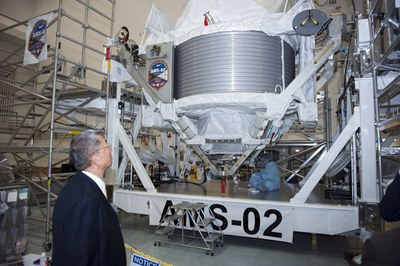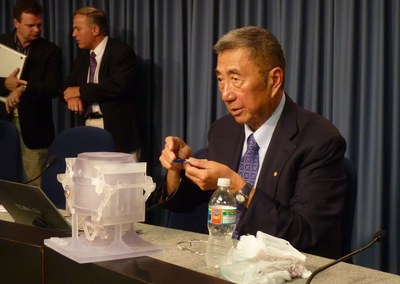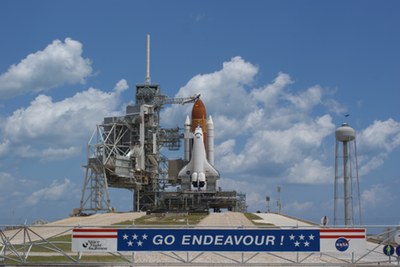The space station’s billion-dollar physics experimentby Jeff Foust
|
| “In a real sense, the International Space Station will transform into a high-energy physics laboratory, with access to the most powerful accelerator in the universe,” said the DOE’s Gonzalez. |
What’s been missing from much of the coverage of the mission is that the launch that so many are flocking to might not be taking place at all were it not for its primary payload, a science experiment called the Alpha Magnetic Spectrometer (AMS). More than 15 years and $1.5 billion in the making, scientists hope the AMS will help provide new insights into the nature of dark matter, antimatter, and other mysteries of the universe. The AMS has also been mired in controversy and very nearly didn’t get a chance to make it to space at all.
ISS as a high-energy physics lab
At its heart, the AMS is a cosmic ray detector. Cosmic rays will pass through the AMS and be bent by its magnetic field, generated by a permanent magnet 4,000 times stronger than the Earth’s own magnetic field. Instruments mounted in the AMS will measure the mass, charge, and energy of the particles that pass through it, including the ability to discern matter from antimatter.
Located above the Earth’s atmosphere, the AMS will be able to detect high-energy particles that would not make it to the surface. “In a real sense, the International Space Station will transform into a high-energy physics laboratory, with access to the most powerful accelerator in the universe, which is the universe itself,” said Saul Gonzalez of the Department of Energy’s (DOE) Office of High-Energy Physics at a press conference at the Kennedy Space Center (KSC) prior to last month’s launch attempt.
The nearly 7,000-kilogram AMS, cradled in the Endeavour’s cargo bay, will be moved to a site on the station’s S3 truss during the fourth day of the STS-134 mission. Unlike typical ISS experiments, once there the AMS will largely operate without interaction with the station’s crew. Instead, the AMS will take advantage of the station’s infrastructure, including power and communications, to operate and transmit its data to scientists back on Earth.
And what will scientists be looking for in the AMS data? One particular area of interest will be detection of antimatter. While models of the origins of the universe predict that matter and antimatter should have formed in equal proportions, matter dominates all our observations of the universe to date. Detections of antimatter by the AMS, particularly heavy particles like antihelium or anticarbon nuclei that could only have formed after the Big Bang, could provide evidence of the existence of antimatter in larger quantities elsewhere in the universe. Separately, detections of excess amounts of positrons—antimatter electrons—could be evidence of collisions of hypothetical particles called supersymmetic neutralinos that could comprise dark matter.
“Most of our understanding of our cosmos up to now comes from measuring light. Besides the light rays, there are charged particles,” said Samuel Ting, the MIT physicist and Nobel laureate who is the principal investigator for the AMS. Charged particles, he noted, have not be used nearly as much as light to understand the universe. “We are opening a door into a new area.”
 Samuel Ting examines the AMS after it was delivered to the Kennedy Space Center in March. (credit: NASA/KSC) |
Near-death experience
AMS, though, almost didn’t get a chance to open that door. The experiment dates back to the 1990s, when high-energy physicists saw the ISS as an opportunity to mount an experiment to study cosmic rays. With support from NASA and the DOE, an international consortium started work on AMS, flying a precursor instrument on the STS-91 shuttle mission in 1998 (that experiment was also known as the AMS, so the experiment being launched to the ISS is sometimes called the AMS-02.)
| A strong supporter of ISS research in general, Sen. Hutchison held hearings on the potential of AMS and lobbied for its return to the shuttle manifest. |
Work on the AMS continued relatively quietly until around 2005, when NASA, responding to the Columbia accident in 2003 and the decision the following year by the Bush Administration to retire the shuttle by the end of the decade, altered the shuttle program manifest. There was, the agency concluded, no room for the ISS on the missions planned to complete assembly of the station. The instrument was unceremoniously grounded.
Ting and his international consortium moved into high gear to try and get the AMS back on a shuttle flight. “I was very surprised,” Ting recalled. He said that people with NASA, as well as DOE, continued to support flying the experiment. “The best scientists in the United States,” he said, “advised DOE that this was such an important thing we should carry it out.”
“We never gave up hope, because the science was so compelling,” said Gonzalez. “We were very concerned, but things worked out.”
Things worked out in large part because the AMS had a staunch advocate in Congress: Sen. Kay Bailey Hutchison (R-TX). A strong supporter of ISS research in general, she used her position as chair of the space subcommittee of the Senate Commerce Committee to hold hearings on the potential of AMS and lobby for its return to the shuttle manifest.
At times, though, Hutchison appeared to oversell the potential of the AMS, suggesting on at least two occasions that its study of cosmic rays or dark energy could be used to harness those phenomena as energy sources on Earth. “We believe, and Dr. Ting believes, that if we could improve the understanding of that dark energy, that matter, that that would help us find a new source of power, perhaps, if we could harness that energy, maybe a new source of energy that we could use on Earth,” Hutchison said in a May 2006 speech. (Her comments may have instead been referring to superconducting magnet technology that had been developed for inclusion on the AMS that could be spun off for use in terrestrial energy production.)
Regardless of the rationale, though, AMS won support in Congress. A provision in the NASA Authorization Act of 2008 called on the NASA administrator to “take all necessary steps to fly one additional Space Shuttle flight to deliver the Alpha Magnetic Spectrometer and other scientific equipment and payloads to the International Space Station prior to the retirement of the Space Shuttle.” In 2009, NASA formally added the STS-134 mission to the manifest as that additional mission; it was to be the final shuttle mission until NASA converted the “launch on need” backup shuttle into an additional mission, STS-135, slated for launch this summer.
While NASA was effectively forced to add a shuttle mission to accommodate the AMS, project officials praised the space agency for their support for the experiment. Mark Sistilli, the NASA program manager for AMS, credited NASA associate administrator for space operations William Gerstenmaier for his efforts to get AMS back onto the flight manifest. “Without Bill Gerstenmaier we would not be here today.”
 Samuel Ting discusses the mission of the AMS, with a model of the experiment in the foreground, after an April 28th press conference at KSC. (credit: J. Foust) |
Controversy and uncertainty
Perhaps sensitive to its brush with cancellation, the AMS consortium has stepped up its efforts to communicate its mission to the media and the public. For example, at the press conference last month before the scrubbed launch, the consortium distributed a nearly 200-page full-color glossy book about the experiment. (Curiously, one passage in the book referred to the launch of Endeavour carrying the AMS in the past tense: Ting and colleagues “spoke the long awaited words: ‘AMS is Go For Launch’. Moment later AMS began its ascent towards the ISS.”)
| “To advance in physics is to push current knowledge aside,” said Ting. “Exploring new territory with a precision instrument is the key to discovery. What we will really see nobody knows.” |
That PR push has not insulated the AMS from controversy. Some scientists are skeptical about the utility of the experiment and whether it will be able to do cutting-edge science from its perch on the station. Among their concerns: the decision to replace the superconducting magnet originally planned for the AMS with a permanent magnet used on the version of the AMS flown on the shuttle. The permanent magnet will last the life of the station—potentially 10 years or more depending on how long the ISS continues to operate—whereas the superconducting magnet would have exhausted its supply of liquid helium in three years. The superconducting magnet, though, is several times as powerful as the permanent one, leading some to wonder about potential lost science. Others argue the money spent on AMS would have been put to better use on alternative terrestrial or balloon-borne experiments.
Among the skeptics is Gregory Tarlé, a physicist at the University of Michigan, who has been widely quoted as critical of many of the claims made by AMS supporters. He thinks if there were concentrations of antimatter elsewhere in the universe, they would be detected by other means, and positrons created by neutralino collisions could be explained by other means. “Given that it’s not a conclusive experiment, the billions of dollars in expenditures—and the risk of lives in extending the shuttle program—is just not worth it,” he told Science magazine last month.
Asked about Tarlé’s criticism in particular at last month’s KSC press conference, Ting gave a response best described as quixotic. “The University of Michigan is where I went to school. They used to have a very good football team. The last few years, the football team has gone to pot,” he said to laughter from the assembled media. “I have no other answer.”
Ting said that AMS’s biggest discovery might come from a totally unexpected area. At the press conference he showed a table listing a number of major physics and astronomy facilities and the scientific rationale used to support their development. In each case, those facilities made key discoveries in areas that had not been anticipated when they were built. The Hubble Space Telescope, for example, helped astronomers discover the presence of dark energy in the universe, something not contemplated when the observatory was launched in 1990, let alone in the preceding decades of development.
“For AMS, I have mentioned that we can look for dark matter, look for antimatter, and look for strangelets,” Ting said, referring to another hypothetical dark matter candidate. “But to advance in physics is to push current knowledge aside. Exploring new territory with a precision instrument is the key to discovery. What we will really see nobody knows.”
